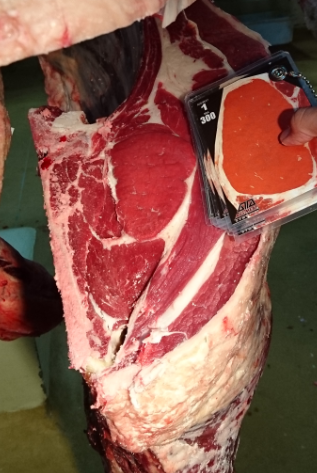The marbling of the meat is an important criterion in the taste experience of the consumer. Visually, it is usually not requested by the consumer, but when tasted, it is popular. It is therefore important to be able to measure it objectively and homogeneously.
In order to improve the taste experience of consumers, the marbling of the meat is considered as one of the major criteria. The more the meat is marbled, the more it is appreciated by consumers. Breeders must produce or carry out technical itineraries for this purpose.
The first step is to measure the marbling of the meat under homogeneous and objective conditions. The evaluation must be as fair and as homogeneous as possible with all the players in the sector.
The first step is for breeders, slaughterers and distributors to base themselves on the same reference. A clear measurement protocol is therefore needed.
Description of Innovation
The objective is to guarantee the harmonization of the assessment between the different slaughtering and cutting establishments.
The marbling should be appreciated on the forequarter at the level of the 5th rib. This corresponds to a classic practice practiced on almost all French carcasses consisting of cutting the ½ carcass into 2 quarters.
Knowledge of the marbling levels is essential for the breeder to define the factors of his breeding which favor him (finishing time, composition of the ration, etc.)
This marbling assessment is the culmination of interprofessional work carried out since 2018. This work materialized following a study conducted by IDELE to establish a grid of 6 different classes, made available to assessors in slaughterhouses. To date, an interprofessional agreement governs these 6 classes, and the use of this grid. Its use remains for the moment voluntary, according to the will of the slaughterers. In 2022, around twenty assessors were trained in France on this grid in slaughterhouses
The first step is therefore to have field experience of this grid. According to feedback, it is planned in the long term to use this grid to better promote the work of breeders by doing:
- A common production condition within the framework of specifications such as the Label Rouge (example: animals with a level of marbling 5 and 6 in the grid)
- A criterion of economic evaluation of the carcass, and added value in the remuneration made to the breeders. To date, only the criteria of conformation and fattening enter into the economic valuation of the carcass. This would therefore ultimately be a third significant evaluation criterion!
- To find the technical itineraries in farms (genetics, food, etc.) that favor marbling.
Impact on farm performance
- better valorization and remuneration of the meat for the breeder, if it is more marbled
- adaptation of livestock management (animal feed, finishing) to increase marbling
- better performance on livestock management
Audio-visual material
Use in slaughterhouse on carcass of the marbling grid :

Farmer comment (for Good Practices)
Francis, a breeder in Moselle, sees the evaluation of marbling as an additional advantage:
“The most important thing is to have a return of the marbling score on the animals that I send to the slaughterhouse, and to have them quickly. Having this feedback makes it possible to associate the note of marbling with the animal feed we give to our animals. Also to ask yourself… “Does finishing animals based on an exclusively corn diet give animals more marble? or not at all ? …” and to adapt the animal feed according to these criteria. Of course, for breeders to push for more marbled meat, prices will have to follow!”
Further information